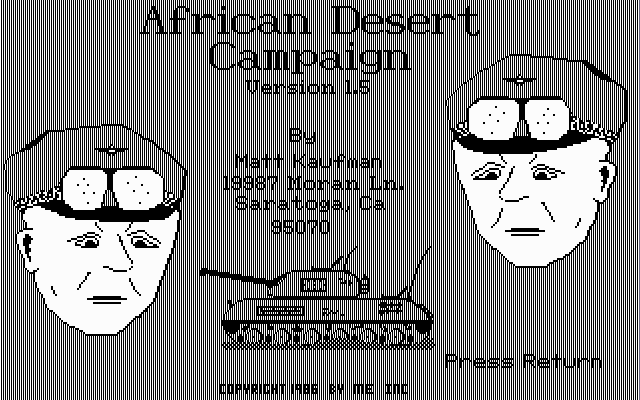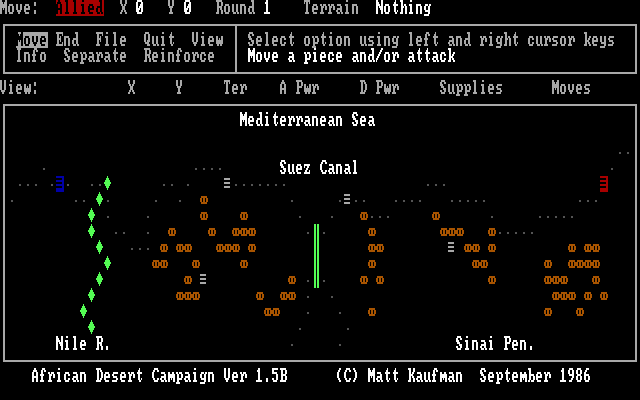Retro Replay Review
Gameplay
African Desert Campaign delivers a classic turn-based strategy experience reminiscent of board-game greats like Risk. You command Allied forces bent on wresting control of the Suez Canal from German defenders. Every move is made via intuitive keyboard controls: use arrow keys or hotkeys to highlight a unit, choose “Move,” “Attack,” “Separate,” or “Reinforce” from the menu at the top of the screen, then confirm your action. Once your turn ends, the enemy AI takes its shot, keeping tension high as you anticipate the outcome of each exchange.
(HEY YOU!! We hope you enjoy! We try not to run ads. So basically, this is a very expensive hobby running this site. Please consider joining us for updates, forums, and more. Network w/ us to make some cash or friends while retro gaming, and you can win some free retro games for posting. Okay, carry on 👍)
Combat hinges on chip-based units: when one of your chips touches an opposing chip, you must engage. The result depends on the munitions and supplies held by both attacker and defender. A victorious strike not only eliminates the enemy piece but also transfers its supplies to your force, rewarding aggressive, well-timed assaults. This interplay between offense, supply management, and risk assessment adds layers of depth to every decision.
Terrain plays a crucial strategic role in African Desert Campaign. Sandy dunes, rocky outcrops, and fortified positions each impose distinct movement penalties, sometimes forcing you to reset your token back to its origin. This careful navigation demands foresight: will you gamble on traversing open desert for speed, or take a longer, safer route through difficult terrain? Thoughtful planning often trumps brute force in this dusty theater of war.
As units expand with victories, you gain access to the Separate command, allowing you to split a large force into smaller detachments for flanking maneuvers. The Reinforce option helps you shuffle supplies among your chips, ensuring that front-line troops don’t run dry at critical moments. Although the learning curve can be steep for newcomers, mastering these mechanics is deeply rewarding, turning each skirmish into a tactical puzzle.
Graphics
Rather than high-fidelity visuals, African Desert Campaign opts for nostalgic ASCII graphics rendered directly in your console or terminal window. Every tile, chip, and mountain is depicted using simple characters, evoking early computer wargames of the 1980s. While this style may feel rudimentary, it communicates essential information cleanly and keeps performance smooth even on modest hardware.
The monochrome palette and stark grid map emphasize clarity over flash, making it easy to distinguish between friendly and enemy units, supply icons, and terrain markers. A concise status line at the top of the screen shows your selected unit’s current supplies, movement allowances, and available commands. This functional layout ensures you’re never hunting through submenus or buried in secondary screens during critical turns.
Despite the lack of animations or dynamic visual effects, combat feedback is immediate: you’ll see the defender’s chip disappear, supply counters update, and your unit’s strength adjust in real time. These simple but effective visual cues help maintain immersion, as every victory or setback is plainly reflected on the battlefield grid.
While modern gamers accustomed to ray-traced textures and cinematic cutscenes may find the presentation sparse, ASCII graphics carry a certain retro charm. For players who appreciate substance over spectacle, the minimalist interface is a reminder that strategic depth can triumph over graphical polish.
Story
African Desert Campaign situates you in the harsh environs of North Africa during World War II, where control of the Suez Canal was critical for supply routes. You step into the boots of an Allied commander tasked with dislodging entrenched German forces. Although there are no voiced cutscenes or sprawling narrative arcs, the historical context provides a compelling backdrop for your strategic operations.
The game’s plot unfolds through scenario briefs before each mission, outlining victory conditions, terrain hazards, and enemy dispositions. These written vignettes offer enough color to spark your imagination, encouraging you to visualize tank columns rolling across dunes and supply convoys inching toward the front lines. Each scenario feels like a standalone chapter in the broader desert war, lending a sense of progression as you advance toward the vital canal.
Inter-unit banter and mission debriefs are kept to a minimum, placing the emphasis firmly on gameplay. This sparse approach to storytelling means the game never interrupts your strategic flow with unnecessary dialogue or long expository text. Instead, the narrative emerges organically through your own tactical successes and failures, letting you craft your own war story on the grid.
For history buffs, African Desert Campaign offers a light educational touch: terrain types mirror real desert features, and supply management reflects the logistical challenges faced by both armies. While purists may crave more depth or historical flavor, the existing framework is enough to immerse players in the struggle for North Africa without bogging down in era-specific minutiae.
Overall Experience
African Desert Campaign shines as a streamlined, strategy-first title that delivers deep decision-making within a straightforward framework. Its blend of Risk-style territory control, supply logistics, and terrain tactics keeps each session fresh, whether you’re wiping out an enemy stronghold or cleverly outmaneuvering a reinforced position. The simplicity of the interface means you spend more time planning and less time navigating complex menus.
That said, the reliance on ASCII graphics and keyboard-only controls may feel archaic to gamers expecting modern polish. The turn-based pace can be deliberate, especially when facing a stalwart AI opponent across many rounds. Some players might find the lack of audiovisual spectacle a barrier to immersion, though others will appreciate the retro atmosphere.
This title is best suited for strategy enthusiasts, retro gaming aficionados, and anyone intrigued by historical wargaming who doesn’t mind a minimalist presentation. It runs on virtually any PC, so it’s an ideal choice for low-spec machines or for those seeking a no-frills strategic challenge.
In sum, African Desert Campaign offers a robust tactical experience framed by a terse but evocative World War II setting. Its blend of resource management, terrain negotiation, and risk-reward combat makes for a compelling war game that rewards patience and planning. If you’re looking to test your wits in the sands of North Africa and don’t need blockbuster graphics to stay engaged, this campaign is well worth your command.
 Retro Replay Retro Replay gaming reviews, news, emulation, geek stuff and more!
Retro Replay Retro Replay gaming reviews, news, emulation, geek stuff and more!





Reviews
There are no reviews yet.